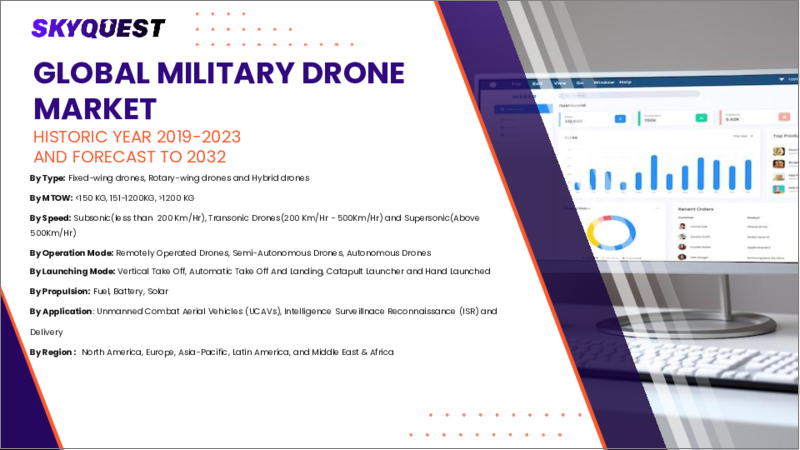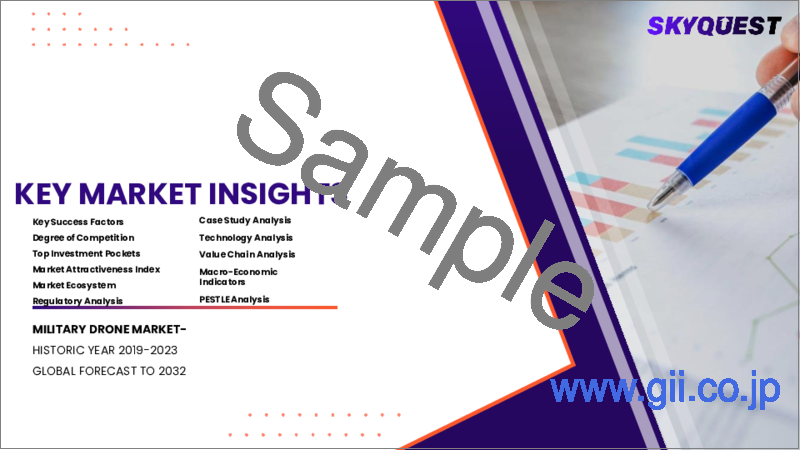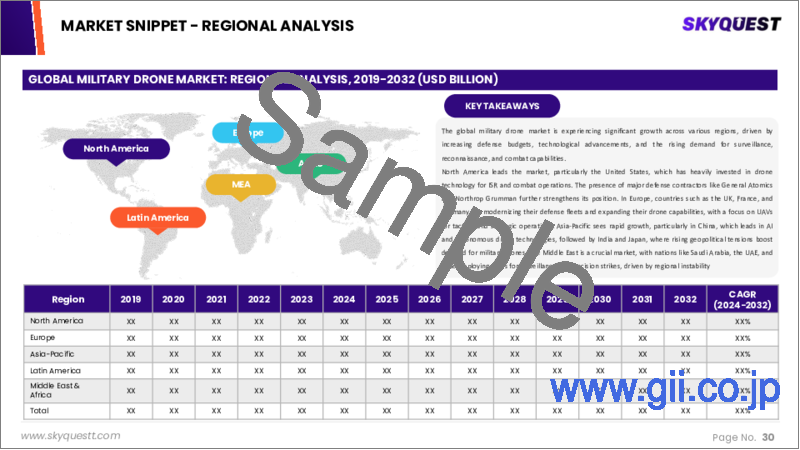|
|
市場調査レポート
商品コード
1610679
軍用ドローンの市場規模、シェア、成長分析、プラットフォーム別、用途別、MTOW別、速度別、タイプ別、操作モード別、発射モード別、推進別、地域別 - 産業予測、2024年~2031年Military Drone Market Size, Share, Growth Analysis, By Platform, By Application, By MTOW, By Speed, By Type, By Operation Mode, By Launching Mode, By Propulsion, By Region - Industry Forecast 2024-2031 |
||||||
|
|||||||
| 軍用ドローンの市場規模、シェア、成長分析、プラットフォーム別、用途別、MTOW別、速度別、タイプ別、操作モード別、発射モード別、推進別、地域別 - 産業予測、2024年~2031年 |
|
出版日: 2024年12月08日
発行: SkyQuest
ページ情報: 英文 197 Pages
納期: 3~5営業日
|
全表示
- 概要
- 目次
世界の軍用ドローン市場規模は2022年に129億米ドルと評価され、2023年の145億米ドルから2031年には339億米ドルに成長し、予測期間中(2024-2031年)のCAGRは11.2%で成長する見通しです。
ドローン産業は、技術の進歩、アプリケーションポートフォリオの進化、コストの低下によって大きな成長を遂げています。技術革新により、優れた機能、より長い飛行時間、高度な画像システム、障害物回避の強化などを備えたドローンが登場し、その用途は写真撮影にとどまらず、インフラ点検、農業監視、軍事作戦などの複雑なタスクにまで拡大しています。ドローンは、農村部でのインターネット接続の提供や環境調査のサポートなど、さまざまな商業用途への採用が進んでいます。さらに、軍用ドローンテクノロジーは、特にステルス性、人工知能(AI)、群技術において大幅な進歩を遂げ、自律的な意思決定とリアルタイムのデータ処理を可能にしています。これらの進歩は軍事戦略を再構築しており、探知を回避するように設計されたドローンは、様々な分野での作戦効果を高めています。
目次
イントロダクション
- 調査の目的
- 調査範囲
- 定義
調査手法
- 情報調達
- 二次データと一次データの方法
- 市場規模予測
- 市場の前提条件と制限
エグゼクティブサマリー
- 世界市場の見通し
- 供給と需要の動向分析
- セグメント別機会分析
市場力学と見通し
- 市場概要
- 市場規模
- 市場力学
- 促進要因と機会
- 抑制要因と課題
- ポーター分析と影響
- 競争企業間の敵対関係
- 代替品の脅威
- 買い手の交渉力
- 新規参入業者の脅威
- 供給企業の交渉力
主な市場の考察
- 重要成功要因
- 競合の程度
- 主な投資機会
- 市場エコシステム
- 市場の魅力指数(2023年)
- PESTEL分析
- マクロ経済指標
- バリューチェーン分析
- 価格分析
- 技術の進歩
- 規制情勢
- ケーススタディ
- 特許分析
- 貿易分析
軍用ドローン市場規模:プラットフォーム別& CAGR(2024-2031)
- 市場概要
- 小型
- 戦術
- 戦略的
軍用ドローンの市場規模:用途別& CAGR(2024-2031)
- 市場概要
- 無人航空戦闘車両
- 情報監視偵察
- 配達
軍用ドローンの市場規模:MTOW別& CAGR(2024-2031)別
- 市場概要
- 150キログラム未満
- 151-1200キログラム
- 1200キログラム超
軍用ドローンの市場規模:速度別& CAGR(2024-2031)
- 市場概要
- 亜音速
- 超音速
軍用ドローンの市場規模:タイプ別& CAGR(2024-2031)
- 市場概要
- 固定翼
- 回転翼
- ハイブリッド
軍用ドローンの市場規模:操作モード別& CAGR(2024-2031)
- 市場概要
- 遠隔操縦
- 有人操縦オプション
- 完全自律
軍用ドローンの市場規模:発射モード別& CAGR(2024-2031)
- 市場概要
- 垂直離陸
- 自動離着陸
- カタパルトランチャー
- ハンドランチャー
軍用ドローンの市場規模:推進別& CAGR(2024-2031)
- 市場概要
- 燃料駆動
- 電池駆動
軍用ドローン市場規模:地域別& CAGR(2024-2031)
- 北米
- 米国
- カナダ
- 欧州
- 英国
- ドイツ
- スペイン
- フランス
- イタリア
- その他欧州地域
- アジア太平洋
- 中国
- インド
- 日本
- 韓国
- その他アジア太平洋地域
- ラテンアメリカ
- ブラジル
- その他ラテンアメリカ地域
- 中東およびアフリカ
- GCC諸国
- 南アフリカ
- その他中東・アフリカ
競合情報
- 上位5社の比較
- 主要企業の市場ポジショニング(2023年)
- 主な市場企業が採用した戦略
- 市場の最近の動向
- 企業の市場シェア分析(2023年)
- 主要企業の企業プロファイル
- 会社概要
- 製品ポートフォリオ分析
- セグメント別シェア分析
- 収益の前年比比較(2021-2023)
主要企業プロファイル
- General Atomics Aeronautical Systems(United States)
- Northrop Grumman(United States)
- Boeing(United States)
- Kratos Defense & Security Solutions(United States)
- Israel Aerospace Industries(IAI)(Israel)
- Elbit Systems(Israel)
- Textron Systems(United States)
- Lockheed Martin(United States)
- AeroVironment(United States)
- BAE Systems(United Kingdom)
- Airbus(France)
- Leonardo(Italy)
- Thales Group(France)
- Kalashnikov Concern(Russia)
- Shenyang Aircraft Corporation(China)
- Chengdu Aircraft Industry Group(China)
Global Military Drone Market size was valued at USD 12.9 billion in 2022 and is poised to grow from USD 14.5 billion in 2023 to USD 33.9 billion by 2031, growing at a CAGR of 11.2% during the forecast period (2024-2031).
The drone industry is experiencing significant growth driven by technological advancements, an evolving application portfolio, and decreasing costs. Innovations have led to drones with superior capabilities, longer flight durations, advanced imaging systems, and enhanced obstacle avoidance, expanding their uses beyond photography to include complex tasks like infrastructure inspection, agricultural monitoring, and military operations. Drones are increasingly being adopted for various commercial applications, providing internet connectivity in rural areas and supporting environmental surveys. Moreover, military drone technology has seen substantial improvements, particularly in stealth, artificial intelligence (AI), and swarm technology, allowing for autonomous decision-making and real-time data processing. These advancements are reshaping military strategies, with drones designed to evade detection, enhancing operational effectiveness across various sectors.
Top-down and bottom-up approaches were used to estimate and validate the size of the Global Military Drone market and to estimate the size of various other dependent submarkets. The research methodology used to estimate the market size includes the following details: The key players in the market were identified through secondary research, and their market shares in the respective regions were determined through primary and secondary research. This entire procedure includes the study of the annual and financial reports of the top market players and extensive interviews for key insights from industry leaders such as CEOs, VPs, directors, and marketing executives. All percentage shares split, and breakdowns were determined using secondary sources and verified through Primary sources. All possible parameters that affect the markets covered in this research study have been accounted for, viewed in extensive detail, verified through primary research, and analyzed to get the final quantitative and qualitative data.
Global Military Drone Market Segmental Analysis
Global Military Drone Market is segmented by Platform, Application, MTOW, Speed, Type, Operation Mode, Launching Mode, Propulsion and Region. Based on Platform, the market is segmented into Small, Tactical, Strategic. Based on Application, the market is segmented into Unmanned Combat Aerial Vehicles, Intelligence, Surveillance, Reconnaissance, Delivery. Based on MTOW, the market is segmented into <150 KG, 151-1200 KG, >1200 KG. Based on Speed, the market is segmented into Subsonic, Supersonic. Based on Type, the market is segmented into Fixed Wing, Rotary Wing, Hybrid. Based on Operation Mode, the market is segmented into Remotely Piloted, Optionally Piloted, Fully Autonomous. Based on Launching Mode, the market is segmented into Vertical Take Off, Automatic Take Off and Landing, Catapult Launcher, Hand Launched. Based on Propulsion, the market is segmented into Fuel Powered, Battery Powered. Based on Region, the market is segmented into North America, Europe, Asia Pacific, Latin America and Middle East & and Africa.
Driver of the Global Military Drone Market
The Global Military Drone market is experiencing significant growth driven by the escalating demand for advanced photographic surveillance capabilities. As drones gain traction in military operations, manufacturers are increasingly designing versatile systems for diverse commercial applications. This trend is evident across various sectors, including agriculture, environmental monitoring, public services, rescue missions, and advertising. Numerous companies are now producing small drones primarily targeted at agricultural tasks, as well as for aerial imagery and data collection. This convergence of military and civilian drone applications showcases the evolving landscape, highlighting the importance of surveillance technology in both defense and commercial realms.
Restraints in the Global Military Drone Market
The growth of the global military drone market is significantly hindered by stringent regulations that vary widely from country to country. This inconsistent regulatory landscape creates substantial challenges for manufacturers, who must navigate complex compliance requirements when developing their systems. Furthermore, the restrictions imposed on drone operations in sensitive areas such as airports further limit their usage and deployment. As a result, these regulatory barriers not only stifle innovation and expansion within the industry but also complicate the production process for companies seeking to enter or maintain a presence in the military drone sector.
Market Trends of the Global Military Drone Market
The Global Military Drone market is experiencing a significant trend driven by rapid technological advancements, particularly in areas such as battery life, sensor efficiency, and artificial intelligence. Enhanced functionalities enable drones to undertake complex autonomous missions, improving operational efficiency and reducing human risk. As militaries worldwide prioritize modernization and incorporate cutting-edge technology, the demand for military drones is surging. Additionally, the integration of improved imaging capabilities and real-time data analysis tools is transforming surveillance and reconnaissance missions. This trajectory indicates a robust growth forecast, as nations increasingly adopt these versatile systems for defense and strategic operations, shaping the future of military engagements.
Table of Contents
Introduction
- Objectives of the Study
- Scope of the Report
- Definitions
Research Methodology
- Information Procurement
- Secondary & Primary Data Methods
- Market Size Estimation
- Market Assumptions & Limitations
Executive Summary
- Global Market Outlook
- Supply & Demand Trend Analysis
- Segmental Opportunity Analysis
Market Dynamics & Outlook
- Market Overview
- Market Size
- Market Dynamics
- Driver & Opportunities
- Restraints & Challenges
- Porters Analysis & Impact
- Competitive rivalry
- Threat of substitute
- Bargaining power of buyers
- Threat of new entrants
- Bargaining power of suppliers
Key Market Insights
- Key Success Factors
- Degree of Competition
- Top Investment Pockets
- Market Ecosystem
- Market Attractiveness Index, 2023
- PESTEL Analysis
- Macro-Economic Indicators
- Value Chain Analysis
- Pricing Analysis
- Technological Advancement
- Regulatory Landscape
- Case Studies
- Patent Analysis
- Trade Analysis
Military Drone Market Size by Platform & CAGR (2024-2031)
- Market Overview
- Sall
- Tactical
- Strategic
Military Drone Market Size by Application & CAGR (2024-2031)
- Market Overview
- Unmanned Aerial Combat Vehicle
- Information, Surveillance, Reconnaissance
- Delivery
Military Drone Market Size by MTOW CAGR (2024-2031)
- Market Overview
- <150 KG,
- 151-1200 KG
- >1200 KG
Military Drone Market Size by Speed & CAGR (2024-2031)
- Market Overview
- Subsonic
- Supersonic
Military Drone Market Size by Type & CAGR (2024-2031)
- Market Overview
- Fixed Wing
- Rotary Wing
- Hybrid
Military Drone Market Size by Operation Mode & CAGR (2024-2031)
- Market Overview
- Remotely Piloted
- Optionally Piloted
- Fully Autonomous
Military Drone Market Size by Launching Mode & CAGR (2024-2031)
- Market Overview
- Vertical Take off
- Automatic Take Off and Landing
- Catapult Launcher
- Hand Launched
Military Drone Market Size by Propulsion & CAGR (2024-2031)
- Market Overview
- Fuel Powered
- Battery Powered
Military Drone Market Size & CAGR (2024-2031)
- North America, (Platform, Application, Speed, Type, MTOW, Operation Mode, Launching Mode, Propulsion)
- US
- Canada
- Europe, (Platform, Application, Speed, Type, MTOW, Operation Mode, Launching Mode, Propulsion)
- UK
- Germany
- Spain
- France
- Italy
- Rest of Europe
- Asia-Pacific, (Platform, Application, Speed, Type, MTOW, Operation Mode, Launching Mode, Propulsion)
- China
- India
- Japan
- South Korea
- Rest of Asia Pacific
- Latin America, (Platform, Application, Speed, Type, MTOW, Operation Mode, Launching Mode, Propulsion)
- Brazil
- Rest of Latin America
- Middle East & Africa (Platform, Application, Speed, Type, MTOW, Operation Mode, Launching Mode, Propulsion)
- GCC Countries
- South Africa
- Rest of Middle East & Africa
Competitive Intelligence
- Top 5 Player Comparison
- Market Positioning of Key Players, 2023
- Strategies Adopted by Key Market Players
- Recent Developments in the Market
- Company Market Share Analysis, 2023
- Company Profiles of All Key Players
- Company Details
- Product Portfolio Analysis
- Company's Segmental Share Analysis
- Revenue Y-O-Y Comparison (2021-2023)
Key Company Profiles
- General Atomics Aeronautical Systems (United States)
- Company Overview
- Business Segment Overview
- Financial Updates
- Key Developments
- Northrop Grumman (United States)
- Company Overview
- Business Segment Overview
- Financial Updates
- Key Developments
- Boeing (United States)
- Company Overview
- Business Segment Overview
- Financial Updates
- Key Developments
- Kratos Defense & Security Solutions (United States)
- Company Overview
- Business Segment Overview
- Financial Updates
- Key Developments
- Israel Aerospace Industries (IAI) (Israel)
- Company Overview
- Business Segment Overview
- Financial Updates
- Key Developments
- Elbit Systems (Israel)
- Company Overview
- Business Segment Overview
- Financial Updates
- Key Developments
- Textron Systems (United States)
- Company Overview
- Business Segment Overview
- Financial Updates
- Key Developments
- Lockheed Martin (United States)
- Company Overview
- Business Segment Overview
- Financial Updates
- Key Developments
- AeroVironment (United States)
- Company Overview
- Business Segment Overview
- Financial Updates
- Key Developments
- BAE Systems (United Kingdom)
- Company Overview
- Business Segment Overview
- Financial Updates
- Key Developments
- Airbus (France)
- Company Overview
- Business Segment Overview
- Financial Updates
- Key Developments
- Leonardo (Italy)
- Company Overview
- Business Segment Overview
- Financial Updates
- Key Developments
- Thales Group (France)
- Company Overview
- Business Segment Overview
- Financial Updates
- Key Developments
- Kalashnikov Concern (Russia)
- Company Overview
- Business Segment Overview
- Financial Updates
- Key Developments
- Shenyang Aircraft Corporation (China)
- Company Overview
- Business Segment Overview
- Financial Updates
- Key Developments
- Chengdu Aircraft Industry Group (China)
- Company Overview
- Business Segment Overview
- Financial Updates
- Key Developments






